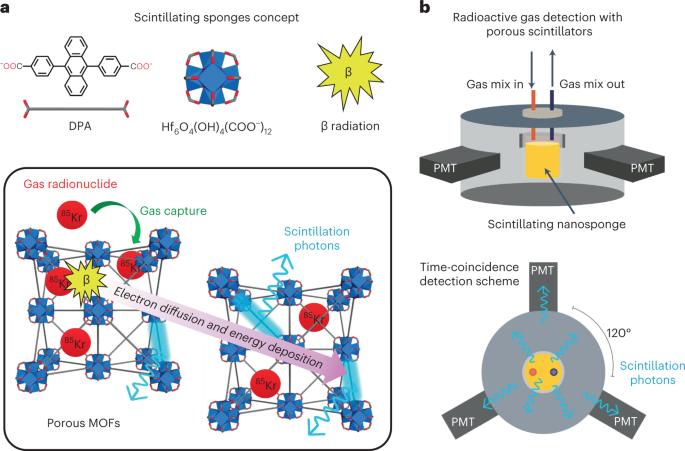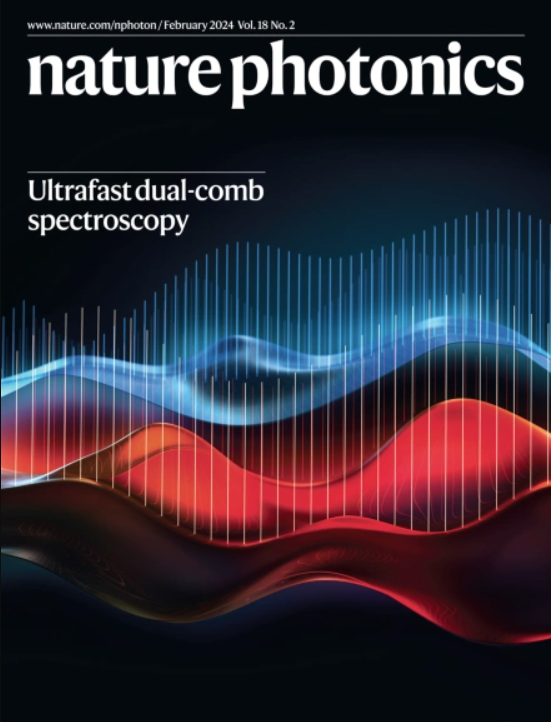Efficient radioactive gas detection by scintillating porous metal–organic frameworks
IF 32.3
1区 物理与天体物理
Q1 OPTICS
引用次数: 3
Abstract
Natural and anthropogenic gas radionuclides such as radon, xenon, hydrogen and krypton isotopes must be monitored to be managed as pathogenic agents, radioactive diagnostic agents or nuclear activity indicators. State-of-the-art detectors based on liquid scintillators suffer from laborious preparation and limited solubility for gases, which affect the accuracy of the measurements. The actual challenge is to find solid scintillating materials simultaneously capable of concentrating radioactive gases and efficiently producing visible light revealed with high sensitivity. The high porosity, combined with the use of scintillating building blocks in metal–organic frameworks (MOFs), offers the possibility to satisfy these requisites. We demonstrate the capability of a hafnium-based MOF incorporating dicarboxy-9,10-diphenylanthracene as a scintillating conjugated ligand to detect gas radionuclides. Metal–organic frameworks show fast scintillation, a fluorescence yield of ∼40%, and accessible porosity suitable for hosting noble gas atoms and ions. Adsorption and detection of 85Kr, 222Rn and 3H radionuclides are explored through a newly developed device that is based on a time coincidence technique. Metal–organic framework crystalline powder demonstrated an improved sensitivity, showing a linear response down to a radioactivity value below 1 kBq m−3 for 85Kr, which outperforms commercial devices. These results support the possible use of scintillating porous MOFs to fabricate sensitive detectors of natural and anthropogenic radionuclides. Detection of gas radionuclides is limited in sensitivity with present methods, but may be useful in energy, security, medical and other sectors. In this work, gas-concentrating porous scintillating metal–organic frameworks are demonstrated for gas radionuclide detection.

通过闪烁多孔金属-有机框架进行有效的放射性气体检测
必须对氡、氙、氢和氪同位素等天然和人为气体放射性核素进行监测,以便将其作为病原体、放射性诊断剂或核活动指标加以管理。基于液体闪烁体的最新探测器存在制备费力、对气体的溶解度有限等问题,从而影响了测量的准确性。如何找到既能浓缩放射性气体,又能有效产生高灵敏度可见光的固体闪烁材料,是目前面临的实际挑战。金属有机框架(MOFs)的高孔隙率和闪烁构件的使用为满足这些要求提供了可能。我们展示了一种以铪为基质的 MOF,其中加入了二羧基-9,10-二苯基蒽作为闪烁共轭配体,用于检测气体放射性核素。金属有机框架闪烁速度快,荧光产率高∼40%,孔隙度大,适合容纳惰性气体原子和离子。通过新开发的基于时间重合技术的装置,探索了 85Kr、222Rn 和 3H 放射性核素的吸附和检测。金属有机框架晶体粉末的灵敏度有所提高,对 85Kr 的线性响应可低至低于 1 kBq m-3 的放射性值,优于商业装置。这些结果支持利用闪烁多孔 MOFs 制造灵敏的天然和人为放射性核素探测器。目前的方法对气体放射性核素的检测灵敏度有限,但在能源、安全、医疗和其他领域可能有用。本研究展示了用于气体放射性核素检测的气体聚光多孔闪烁金属有机框架。
本文章由计算机程序翻译,如有差异,请以英文原文为准。
求助全文
约1分钟内获得全文
求助全文
来源期刊

Nature Photonics
物理-光学
CiteScore
54.20
自引率
1.70%
发文量
158
审稿时长
12 months
期刊介绍:
Nature Photonics is a monthly journal dedicated to the scientific study and application of light, known as Photonics. It publishes top-quality, peer-reviewed research across all areas of light generation, manipulation, and detection.
The journal encompasses research into the fundamental properties of light and its interactions with matter, as well as the latest developments in optoelectronic devices and emerging photonics applications. Topics covered include lasers, LEDs, imaging, detectors, optoelectronic devices, quantum optics, biophotonics, optical data storage, spectroscopy, fiber optics, solar energy, displays, terahertz technology, nonlinear optics, plasmonics, nanophotonics, and X-rays.
In addition to research papers and review articles summarizing scientific findings in optoelectronics, Nature Photonics also features News and Views pieces and research highlights. It uniquely includes articles on the business aspects of the industry, such as technology commercialization and market analysis, offering a comprehensive perspective on the field.
 求助内容:
求助内容: 应助结果提醒方式:
应助结果提醒方式:


